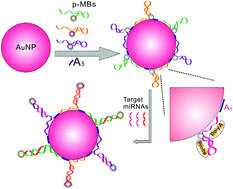Elaborately designed diblock nanoprobes for simultaneous multicolor detection of microRNAs†
Abstract
Simultaneous detection of multiple biomarkers has important prospects in the biomedical field. In this work, we demonstrated a novel strategy for the detection of multiple microRNAs (miRNAs) based on gold nanoparticles (Au NPs) and polyadenine (polyA) mediated nanoscale molecular beacon (MB) probes (denoted p-nanoMBs). Novel fluorescent labeled p-nanoMBs bearing consecutive adenines were designed, of which polyA served as an effective anchoring block binding to the surface of Au NPs, and the appended hairpin block formed an upright conformation that favored the hybridization with targets. Using the co-assembling method and the improved hybridization conformation of the hairpin probes, we achieved high selectivity for specifically distinguishing DNA targets from single-base mismatched DNA targets. We also realized multicolor detection of three different synthetic miRNAs in a wide dynamic range from 0.01 nM to 200 nM with a detection limit of 10 pM. What's more, we even detected miRNAs in a simulated serum environment, which indicated that our method could be used in complex media. Compared with the traditional method, our strategy provides a promising alternative method for the qualitative and quantitative detection of miRNAs.


 Please wait while we load your content...
Please wait while we load your content...